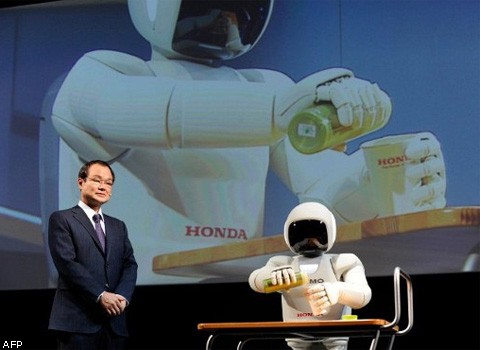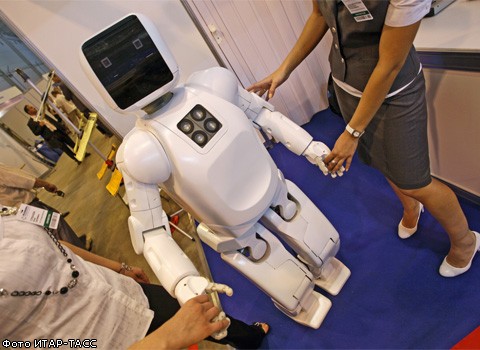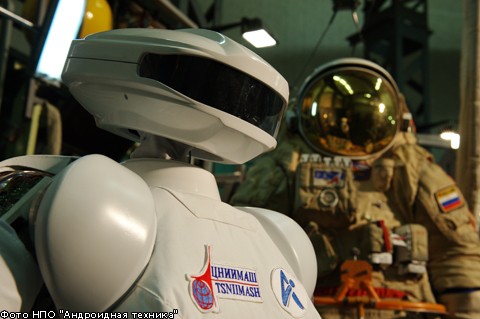Reasonable machines, imperceptibly for humanity, have entered our lives: robots today are doing hard work in conditions excluding the presence of a person – they are fighting, teaching, mastering space, helping to treat and save people. It seems that in the future they will replace Homo sapiens and in more thin areas such as cooking or art. And even if our automated assistants are not as reasonable as representatives of the human race, but now we can say that the ideas of the fantasy writers of the 20th century are slowly but surely implemented.
Human -like robots will appear everywhere except Russia
Reasonable machines, imperceptibly for humanity, have entered our lives: robots today are doing hard work in conditions excluding the presence of a person – they are fighting, teaching, mastering space, helping to treat and save people. It seems that in the future they will replace Homo sapiens and in more thin areas such as cooking or art. And even if our automated assistants are not as reasonable as representatives of the human race, but now we can say that the ideas of the fantasy writers of the 20th century are slowly but surely implemented.
When to wait for humanity to the appearance of fantastic Androids, preparing dinner and meeting guests, and why does Russia not keep up with the leading world powers in the development of smart machines?
From the drawings of Leonardo da Vinci to the Japanese asimo
From the very beginning of the era of constructing robots, the inventors tried to make them similar to people. The first drawing of a mechanical knight, created around 1495, belongs to the hand of the great scientist Leonardo da Vinci. Many later, attempts to collect humanoid robots were made by violent engineers in different countries of the world. However, the vast majority of them were of the nature of mystification – the press now and then exposed the next charlatan, who hid in a “rational” pseudo -elaborate a person or a trained animal.
The word robot itself went into a wide circulation after publication in 1921. Players of the Czech writer Karel Chapek R. U. R. (Rossum universal robots). Later, in the books of the famous science fiction writer Isaek Azimov, the concepts of robotics and Android (human-like robot) appeared.
The impetus for the development of robotic systems in the world has become violent industrialization and the beginning of space development in the 20th century. In 1913 One of the first robotic lines was installed at the Henry Ford enterprise in the United States. In the 1930s. Various devices were created that copy the human movements and reproduce the simplest phrases. The first such robot was designed by the American engineer D. Uexli for the World Exhibition in New York in 1927. In the 1950s. To work with radioactive materials, mechanical manipulators were developed that copy the movements of a person’s hands, and the first serious robots were lunar drives. In the Soviet Union, Lunokhod-1 was created in 1966.In November 1970 He became the first apparatus to conquer the moon (as you know, on July 20, 1969, a man, the American astronaut Neil Armstrong) first stepped onto the Earth's satellite). In the second half of the 20th century, scientists actively improved robots, making them more and more functional, and the appearance of computers opened up unprecedented opportunities for developing the foundations of artificial intelligence.
At the beginning of the XXI century, a new era of smart Androids began. The first serious humanoid robot, SDR-3X was represented by the Japanese company Sony in November 2000. In the same year, the audience got acquainted with the much better well -known android of ASIMO manufactured by Honda, which became the embodiment of the advanced achievements of science and technology. One of the last ASIMO samples has a height of 130 cm, a mass of 48 kg, is able to move at a speed of up to 9 km/h. It is currently the most perfect android. Asimo, for example, can recognize familiar faces of people and contact them by name. In total, about 100 copies of this robot, worth $ 1 million, were released.


How much the Russian economy will fall: forecasts and assessments of economists
What problems are Russians who have bought gold bars

The usual web analytics tools have become dangerous: what are the reasons
Work for which an employee needs to pay not only a salary

How importers were able to defend themselves from the high volatility of the ruble

Risks of personnel reduction: how not to fall into a trap

Ten methods that will help the leader avoid burnout
How to arrange a mess in the finance of the company – eight bad habits
Android with a human face
Although most modern robots do not at all look like people, they use the special attention of the public, oddly enough, androids. Obviously, the first of them will not have a European face. The advanced in this regard is Japan, which created a real cult of robots. Here, large corporations and craftsmen are engaged in their construction, which is encouraged by the government.
For these purposes, according to the long-term program for the development of robot construction in 2007-2016. Japan plans to send about $ 260 billion. By this time, the Japanese intend to bring to 6 trillion yen ($ 73.8 billion). Androids are given a special role – in the future they should become assistants in the household. It is assumed that by 2025. In developed countries, home robots will become as familiar as a computer or washing machine. However, some Russian specialists in the field of robotics believe that androids will remain expensive toys. The robot is a narrow -functional machine that should perform certain tasks, not a universal mechanism. Therefore, it is unlikely that home androids will once become the same widespread as modern household appliances, said Arkady Yushchenko, head of the Bauman Robotics Systems.
In the country of the rising sun, scientists seem to adhere to a different point of view. They enthusiastically create their exact copies-robots and even teach them to portray emotions. The development of Androids are known Professor Hiroshi Ishiguro. His last work, presented in April 2012. -Geminoid F, who can smile, talk and even sing. In 2005 Japanese scientists invited the customers of Android Wakamaru, who can not only clean the house, but is also able to distinguish people in their faces, remind you of planned affairs and warn the hosts about attempts to hack their home. True, such assistants are expensive: the price of Vakamaru starts from 15 thousand dollars.
And if for the average buyer, due to the high cost, the assistant robots are still doubtful, then for business the replacement of a person with an intelligence car is beneficial today. This is proved by the transaction for the purchase of American Amazon, working in the field of retail sales of goods via the Internet, the largest manufacturer of robots for logistics – Kiva Systems Inc. It is assumed that a transaction, the cost of which is estimated at $ 775 million, will be completed in the second quarter of 2012. Obviously, large companies are betting on the use of robots instead of holding the staff of the movers. KIVA robotic warehouse systems are used today by CRate Barrel, Gap Inc. and Diapers.com.
Android SAR -400 – Our answer NASA
More persistently dictates the use of robots by the development of space. The Robonavt-2 humanoid robot (R-2) production of NASA and General Motors in test mode is already working at the International Space Station. Android looks like half a man (his legs are absent) and costs about $ 2.5 million.
In Russia, the creation of the domestic analogue of the Robonaut is engaged in the Scientific and Production Association Android Technique by order of the Federal Space Agency of the Russian Federation (Roscosmos). The Russian Android SAR-400, like foreign, can be used to carry out technical and rescue operations both on the ISS itself and beyond. In addition, it is intended for the information and psychological support of the crew of the station. “In fact, this means the possibility of communicating with a robot for psychological unloading,” the android technique press service explained. The Russian robot cosmonaut weighs 30 kg with a height of 63 cm and has a scope of the manipulators of 1.65 m.
It differs from the foreign in lower dimensions and mass, as well as the ability of the operator to feel an object of manipulation – the effect is achieved due to the silage reflection of efforts. The last property is a kind of know -how of Russian scientists. Robots with the ability to transmit tactile sensations to the operator in the world units. SAR-400 works in several modes: you can control it by wearing a special suit, and using video cameras. The electronic assistant to astronauts can also follow instructions under a predetermined program.When the Russian Robocosanaut joins his foreign colleague, it is not yet known – the deadlines are agreed with Roscosmos. The cost of creating SAR-400 in the NGO Android technique also did not voice, referring to the fact that the project has not yet been completed.
Machine vehicles will replace the soldier
Robotized systems today are widely used for military purposes. Judging by investment in this sphere and the pace of its development, it is very likely that the terminators with artificial intelligence will appear much earlier than household assistants. Fighting robots are most often used in intelligence and as automated fire support systems.
The USA leads in the creation of military vehicles. Operations with the use of consolers have already become familiar. In 2012 The Pentagon plans to purchase more than a thousand “pocket” reconnaissance robots of the Recon Scout XT Throwbot in the amount of about 14 million dollars. In addition, it has recently been known about the continuation of the project to create an unmanned ActUV swimming apparatus, designed to monitor submarines in the open ocean (including submarines carrying nuclear weapons). This was announced by the agency of advanced defense research projects of the United States (DARPA).
Although robots still cannot fully fight instead of living infantrymen, already in 2020. Americans expect to change the situation. Plans for replacing soldiers are contained in a report on the development of military robots in the United States until 2032, published by the Pentagon back in 2007. The authors of the document note that there are a great future behind such systems, and the first samples of autonomous military equipment have already proved their effectiveness in Afghanistan and Iraq. As the main advantages of robots, the military calls the absence of the need to allow living people into battle, a potential cheapness in the case of mass production and their increased combat characteristics. It is also obvious that weapons for robots will repeatedly exceed the human in power, rate of fire and accuracy.
Development of combat robots is actively conducted in other countries, including in Russia. The new Russian tank based on the heavy platform of armored vehicles Armata plan to equip a digital gun with remote control. Military experts argue that the appearance of such a gun will bring Russia closer to the creation of completely autonomous robots tanks. However, the US military budget in any comparison is not compared with the budgets of other countries. For the needs of the Pentagon in 2012. 662 billion dollars will be spent, the military budget of Russia this year will amount to $ 59.1 billion.
Avatar in Russian
If Russia tries to keep the brand in the military field, mindful of the past status of superpower, then the construction of household robots in their native Fatherland are only engaged in enthusiasts-enthusiasts. Today, this direction is represented by the so -called robots of television name.With the help of built-in display, cameras, microphone and speakers, they allow the operator to actually be attended by any event without getting up from the computer.
The technology resembles a video conference, but the robot gives freedom of movement (the user from the computer controls the movement of the robot, which is equipped with two leading wheels), and due to its human -like features, the effect of presence is achieved. Such Russian-made robots resemble a barrel-shaped R2-D2 droid from Star Wars, only they are taller than 1.3 m) and look more attractive. Large companies use them in organizing exhibitions and advertising shares as promoters and PR managers. The first Russian telecommunication robots are used in other areas: during conferences and seminars, training, monitoring patients in medical institutions, etc.
With a dozen television -owned robots are used in Moscow schools, helping children study. For example, a ninth grader of the Moscow Education Center No. 166, to whom heart problems do not allow the institution to visit, is learning remotely with the help of such a machine. Domestic robot-avatar of civilian use differs from foreign analogues of relative cheapness-3 thousand dollars. For such models VGO or Anybots QB (produced in the USA), 6-15 thousand dollars will have to be laid out.
It would seem that the competitive advantage is evident and there are all the prerequisites for entering foreign markets. But, as it turned out, the company constructing such robots is almost the only one in Russia. “The sphere itself is very high -tech and costly, requiring significant monetary investments,” explains the reason Alexei Knyazev, director of R.bot, which produces television in telecommunication. “We have no tax benefits, that is, for the IT sphere, and for the robot building for why- then no. We were not included in the state program – apparently, they considered that the country does not have enough specialists to develop this direction. There are experts, the desire to work is also, the only thing is for serious investments, but only they are not and are not expected, A.Knyazev notes. As it turned out, a similar situation has developed in our country throughout the industry as a whole.

Seven troubles of Russian robot construction
Most industrial robotic complexes, robots for medicine, nodes and elements for special robots, Russia today acquires abroad for fabulous amounts. The industry experts evaluate the level of robotization of production as extremely low, and domestic enterprises engaged in the construction and production of robots can literally count on the fingers of one hand. After the collapse of the Union on its ruins, Russian robot building did not manage to grow. A little more, and the missed will never succeed, experts say.
The first and main reason is the extremely scarce public funding. There is simply no special state program to support the development of robotics in Russia. Over the past two convocations, nothing of the kind in this regard at the level of bills has been submitted to the State Duma and has not been adopted, at least over the past five years for sure, the press service of the State Duma Committee on Science and Science-Intensive Technologies told RBC. Neither the Ministry of Economic Development nor the Ministry of Industry and Trade of the Russian Federation could say anything about this.
Private investors could help domestic robot builders, but Russian business is in no hurry to invest in long-term projects. “Russian entrepreneurs have a slightly different psychology than in the West. Any economic calculation shows the profitability of investing in high-tech industries, but as soon as it comes to the fact that investments will pay off in 10 years, interest in projects immediately dries up,” says Advisor to the Director of the Central Research Institute of Robotics and technical cybernetics Alexander Zheleznyakov.
Other pain points are the lack of an element base (parts and assemblies have to be purchased abroad) and staff shortages. Young personnel today make up about 5%, but not all of them remain in the industry. There are experienced professionals, but they are aging. And when they leave, there will be no one to fill this vacuum created by the demographic hole of the 1990s, adds A. Zheleznyakov .

In Russia, not only robotics, but mechanical engineering as a whole, for some reason, is not a priority area of development, says Sergei Gavryushin, head of the department of computer systems for industrial automation at Bauman Moscow State Technical University. He notes that IT, nanotechnologies, transport and space systems, the fight against terrorism, the development of weapons, and energy have been identified as priorities by the state (we are talking about the decree of the President of the Russian Federation On approval of priority areas for the development of science, technology and technology in the Russian Federation, signed D. Medvedev 07/07/2011 – note RBC). Engineering is not among them, the expert states. On what technological base all these nanotechnologies, IT and military developments will develop without mechanical engineering, one can only guess. According to S. Gavryushin, there are still specialists in the industry, but there are no major projects in Russia where this scientific potential could be realized.
In conclusion, it must be said that today the capacity of the global robotics market can be safely estimated at billions of dollars. However, Russia is unlikely to be able to claim any significant piece of this pie in the foreseeable future. Therefore, we will have living cosmonauts for a long time to explore space, and visitors from the CIS and Central Asia will work as waiters, janitors and loaders.
